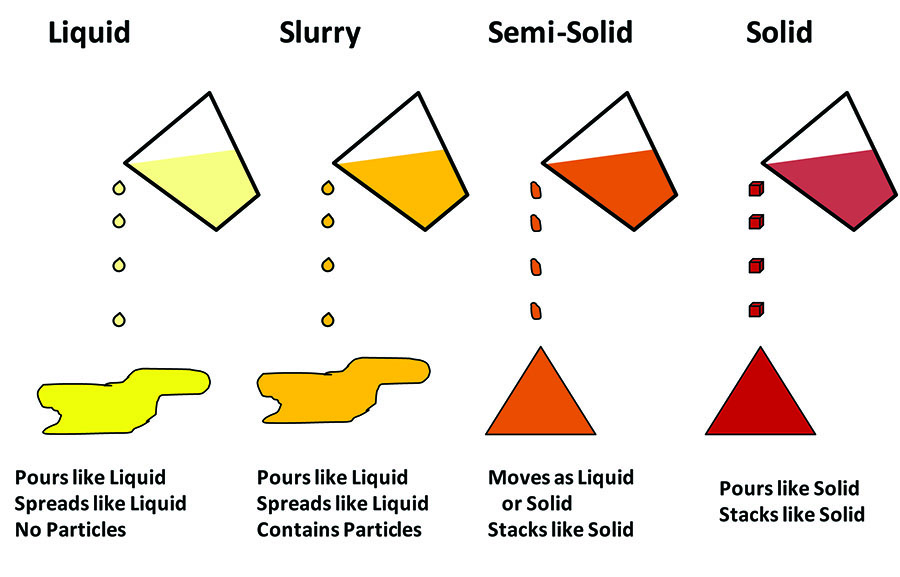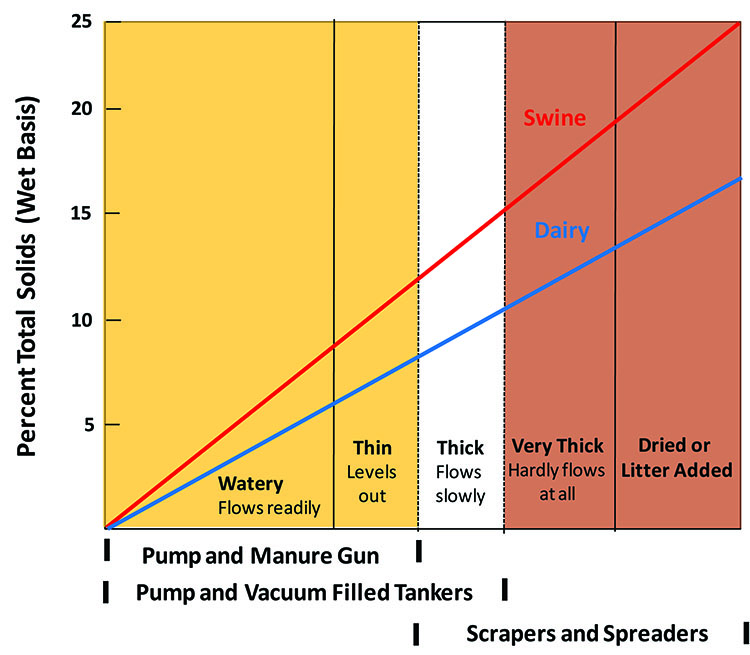Consistency of Manure/Water Mixtures
Whether manure is scraped, squeegeed, slurped, sloshed, or slung depends on its consistency. Consistency is the measure of how well a material holds together and maintains a shape.
Four States of Consistency
As seen in Figure 1, mixtures of solids and liquids exist in four states of consistency
- Liquids contain no solid particles. True liquids are rare in animal waste handling. Two exceptions are urine and lagoon effluent.
- Slurries act like liquids, but contain solid particles. Slurries require special pumps and nozzles to handle the solids.
- Semi-solids are somewhere between a solid and liquid. They stack like solids, but can move like liquids. A fresh cow pie is a good example. It sits in the field as a stack, but step on it and it squirts like a liquid.
- Solids never act like a liquid. No matter how hard you step on a pile of broiler litter, it will never squirt.
Figure 1. The Four States of Manure Consistency.
Effect of Solids Content and Particle Shape on Consistency
Consistency depends on the solids content and the type of manure in the mixture.
Figure 2 shows the consistency of swine, poultry, beef, and dairy manure at contents up to 30 percent total solids.
Notice the “as excreted” line running through Figure 2. This shows the solids content and consistency at which manure leaves the animal. Swine manure is excreted at approximately 10 percent solids, and has the consistency of slurry. Manure from both dairy and beef cattle is excreted at a slightly higher content than swine and has a semi-solid consistency. Dairy manure does not act as slurry unless solids content is well below 8 percent.
Why this difference between swine and dairy manure? The key is the shape of particles.
Swine diets are made of ground grains and processed soybeans, so swine manure solids are small cubes and spheres. Increasing the liquid in a mixture composed of these solids will cause the particles to float away from each other. That is why swine manure is often diluted and handled as thin slurry. Cattle manure solids, derived from high forage diets, are long and stringy. Adding liquid to a mass of tangled fibers will not change its basic shape.
Use Figure 2 with caution. Consistency of manure is highly dependent on diet. Dairy farmers switching from a high forage to a high grain diet may be surprised to find manure oozing out of the dry stack like a milk shake. The change in diet converted the cow’s stringy manure solids to more swine-like, cubical solids.
Often, bedding is added to manure to make it more solid, but all types of bedding do not have the same effect on consistency. Sand, with its non-absorptive, single grain structure, is less cohesive than wood shavings; therefore, it may take a greater mass of sand to solidify manure compared to wood shavings.
Figure 2. Consistency of Manure Based on Solids Content and Species of Animal (from USDA-NRCS. 1992. Agricultural Waste management Field Handbook. Washington, DC: USDA Natural Resources Conservation Service.)
Dependence of Equipment Selection on Consistency
Figure 3 uses a slightly different system to describe the consistency of manure. Manure consistency in this figure ranges from watery to thin to thick and very thick. The colors in Figure 3 roughly correspond to those in Figures 1 and 2: Manure in the golden area is slurry. Manure in the brown area is semi-solid.
The main use of Figure 3 is to aid in the selection of manure removal and spreading equipment based on manure consistency.
Swine manure is excreted at 10 percent Total Solids. Find 10 percent on the left side of the figure, and draw a straight line across the page. The area where this line crosses the red, swine manure line is described as thin manure (or slurry). Go straight down from the intersection. According to this figure, you should use a pump or vacuum tank to remove this material from a pit, and you could use either a manure gun or the vacuum tank to spread the manure on a field. In order to scrape swine manure, you would either have to add bedding or allow the excreted manure to dry until its solid content exceeds 12 percent.
High forage dairy manure is excreted at 13 percent Total Solids, and according to this chart, it is a natural for scrapers. To pump and spray dairy manure, you would have to add an equal mass of water to fresh manure and bring solids content below 7 percent.
Figure 3. Collection and Spreading Equipment Selection Based on Manure Consistency. (from C.P. Schofield. 1984. A Review of the handling characteristics of agricultural slurries. J. Agric. Eng. Res. 30:101-109.)
Douglas W. Hamilton
Extension Waste Management Specialist
Biosystems and Agricultural Engineering



